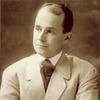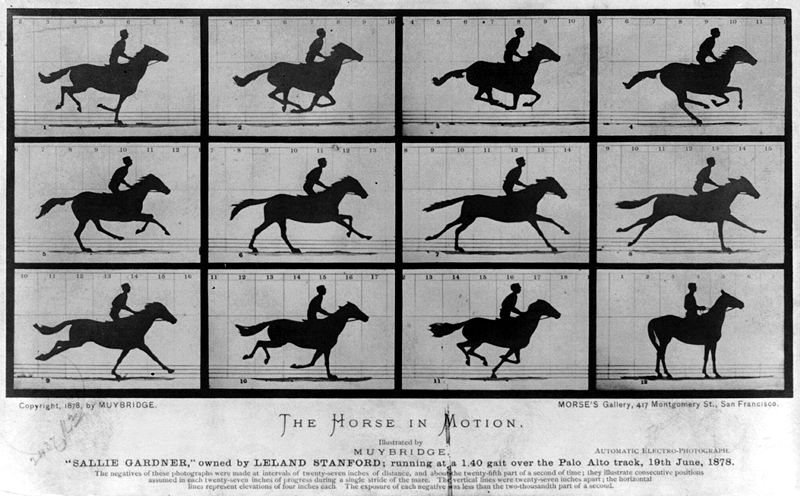When Was The First Animated Film Made
Animation is one of the most ubiquitous and all-permeating forms of visual communication today, seen everywhere from the multitude of TV channels dedicated solely to cartoons to the title sequences of our favorite movies to the reactive graphic interfaces our smartphones. And while well-nigh of us have a vague thought of how, when, and where information technology all began, we tend to take for granted the incredible visual wizardry possible today. With that in mind, hither'due south a brief history of the beloved medium's ancestry through the seminal work of five early animation pioneers.
1. COHL: FANTASMAGORIE (1908)
 French cartoonist and animator Émile Cohl is oft referred to as "the father of the animated cartoon." The legend goes that in in 1907, when motion pictures were reaching disquisitional mass, the fifty-year-old Cohl was walking downwardly the street and spotted a poster for a picture clearly stolen from one of his comic strips. He confronted the manager of the offending studio, Gaumont, in outrage and was hired on the spot as a scenarist—the person generating one-folio story ideas for movies. Between February and May 1908, Cohl created Fantasmagorie, considered the get-go fully animated film ever made.
French cartoonist and animator Émile Cohl is oft referred to as "the father of the animated cartoon." The legend goes that in in 1907, when motion pictures were reaching disquisitional mass, the fifty-year-old Cohl was walking downwardly the street and spotted a poster for a picture clearly stolen from one of his comic strips. He confronted the manager of the offending studio, Gaumont, in outrage and was hired on the spot as a scenarist—the person generating one-folio story ideas for movies. Between February and May 1908, Cohl created Fantasmagorie, considered the get-go fully animated film ever made.
To create the animation, Cohl placed each drawing on an illuminated drinking glass plate and traced the next drawing, reflecting the variations necessary to show movement, over it until he had some 700 drawings. Since chalkboard caricaturists were common vaudeville attractions in the era, the characters in the movie look equally though they've been fatigued on a chalkboard, but it's an illusion—Cohl filmed black lines on newspaper and printed them in negative to make his animations appear to exist chalk drawings.
Fantasmagorie and dozens of other influential early films tin can be plant on Gaumont Treasures Vol. 2: 1908-1916, with over 10 hours of glorious raw material.
two. MÉLIÈS: THE PROLIFIC EGG (1902)
 French filmmaker Georges Méliès is known as the first cinemagician for his early on use of special effects in cinema. Between 1896 and 1914, he directed some 531 films, ranging from one to forty minutes in length, usually featuring single in-camera effects throughout each entire picture show. In 1902, he appeared in 1 of his ain films, 50'oeuf du sorcier (The Prolific Egg)—a groundbreaking exploration of calibration, multiplication, and transitions that truly sealed his reputation as a "cinemagician" and the father of special effects in motion-picture show.
French filmmaker Georges Méliès is known as the first cinemagician for his early on use of special effects in cinema. Between 1896 and 1914, he directed some 531 films, ranging from one to forty minutes in length, usually featuring single in-camera effects throughout each entire picture show. In 1902, he appeared in 1 of his ain films, 50'oeuf du sorcier (The Prolific Egg)—a groundbreaking exploration of calibration, multiplication, and transitions that truly sealed his reputation as a "cinemagician" and the father of special effects in motion-picture show.
Méliès's seminal piece of work can be establish in Georges Méliès: First Magician of Movie theater (1896-1913), an outstanding five-disc collection of 173 rare and rediscovered Méliès gems alongside a beautifully illustrated booklet featuring essays by acclaimed National Movie Board of Canada animator Norman McLaren, and its sequel, Méliès Encore: 26 Additional Rare and Original Films past the First Wizard of Picture palace (1896-1911).
iii. MCCAY: LITTLE NEMO (1911)
 Cartoonist and artist Winsor McCay (1869-1964) is often considered one of the fathers of "true" blitheness.
Cartoonist and artist Winsor McCay (1869-1964) is often considered one of the fathers of "true" blitheness.
His 1911 picture show, Winsor McCay, the Famous Cartoonist of the N.Y. Herald and His Moving Comics, likewise referred to simply every bit Fiddling Nemo and featured here last week, contains two minutes of pure animation at around 8:11, using sequential hand-illustration in a novel way not seen in previous films.
For more on McCay'due south work and legacy, await no further than the stunning and illuminating Winsor McCay: His Life and Art. There'southward also a wonderful Kickstarter project out to resurrect McCay's concluding pic, The Flying House—bring together me in supporting information technology.
4. BLACKTON: THE ENCHANTED Cartoon (1900)
 British filmmaker J. Stuart Blackton is credited with creating the showtime blitheness in America and was among the first in the world to use stop-movement as a storytelling technique. In 1896, Blackton, a reporter for the New York Evening World, was sent to interview Thomas Edison nigh his brand new Vitascope invention. In an historic period where wooing reporters was critical to success, Edison took Blackton to Black Maria, his studio-cabin, and created an impromptu moving picture of Blackton doing a lightning sketch of Edison himself. Blackton became and then infatuated with the technology that he soon founded the American Vitagraph Company and began producing films, debuting with The Enchanted Drawing in 1900.
British filmmaker J. Stuart Blackton is credited with creating the showtime blitheness in America and was among the first in the world to use stop-movement as a storytelling technique. In 1896, Blackton, a reporter for the New York Evening World, was sent to interview Thomas Edison nigh his brand new Vitascope invention. In an historic period where wooing reporters was critical to success, Edison took Blackton to Black Maria, his studio-cabin, and created an impromptu moving picture of Blackton doing a lightning sketch of Edison himself. Blackton became and then infatuated with the technology that he soon founded the American Vitagraph Company and began producing films, debuting with The Enchanted Drawing in 1900.
In the film, previously featured here, Blackton sketches a face up, cigars, and a bottle of wine, and so "removes" these terminal drawings as real objects so that the face appears to react. Although the cease-movement sequence isn't considered "true" animation in technical terms the way Fiddling Nemo, which Blackton co-directed with McCay, is, the technique offered an early glimpse of what animation could become.
Blackton's films are included in The Origins of American Animation, 1900-1921—a fantastic collection of the work that sparked what became 1 of the most powerful and permeating movements in visual creativity.
5. MUYBRIDGE: WALTZING COUPLE (1893)
Though the piece of work of English photographer Eadweard J. Muybridge isn't animation, his animal locomotion studies are amid the earliest visual experiments with moving images, laying the foundations for later forms of videography.
 In 1872, the Governor of California took a public position on a commonly debated question of the era: When a horse gallops, are all 4 of its hooves off the basis simultaneously? Nigh paintings of galloping horses at the fourth dimension showed the front legs extended forwards and the rear legs extended backwards, and then Governor Stanford sided with the "unsupported transit" theory and took it upon himself to bear witness it scientifically. He hired Muybridge to settle the question, who enlisted a series of large cameras using glass plates placed in a line, each triggered past a thread every bit the equus caballus passed. He paired that with a clockwork device. The images were so copied equally silhouettes onto a disc, later viewed on a zoopraxiscope. In 1877, Muybridge finally settled Stanford's question with a single photographic negative showing Stanford's racehorse, Occident, fully airborne in the midst of a gallop.
In 1872, the Governor of California took a public position on a commonly debated question of the era: When a horse gallops, are all 4 of its hooves off the basis simultaneously? Nigh paintings of galloping horses at the fourth dimension showed the front legs extended forwards and the rear legs extended backwards, and then Governor Stanford sided with the "unsupported transit" theory and took it upon himself to bear witness it scientifically. He hired Muybridge to settle the question, who enlisted a series of large cameras using glass plates placed in a line, each triggered past a thread every bit the equus caballus passed. He paired that with a clockwork device. The images were so copied equally silhouettes onto a disc, later viewed on a zoopraxiscope. In 1877, Muybridge finally settled Stanford's question with a single photographic negative showing Stanford's racehorse, Occident, fully airborne in the midst of a gallop.

In 1893, Muybridge used the phenakistoscope—an early on animation device that harnessed the "persistence of vision" principle to create an illusion of motion—to extend his visual studies to animation.

Hans-Christian Adams offers an excellent account of Muybridge'southward piece of work and legacy in Eadweard Muybridge: The Human and Animal Locomotion Photographs, all-time examined in parallel with the work of Muybridge's equally influential French contemporary, Étienne-Jules Marey.
For more on early on animation, y'all won't go wrong with Donald Crafton'due south Before Mickey—the most ambitious history of blitheness from 1898-1928 ever published.
This post likewise appears on Brain Pickings.
Source: https://www.theatlantic.com/entertainment/archive/2011/07/before-walt-disney-5-pioneers-of-early-animation/241448/#:~:text=COHL%3A%20FANTASMAGORIE%20(1908)&text=Between%20February%20and%20May%201908,fully%20animated%20film%20ever%20made.
Posted by: freundyouten.blogspot.com

0 Response to "When Was The First Animated Film Made"
Post a Comment